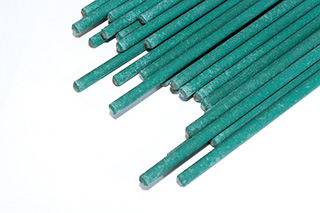TWS is a Great Training Option for Everyone
Learn more about how we can prepare you to advance your career.
If you are interested in a welding career, you might have already looked into the welding tools and equipment that are used. One of the most essential welding tools is the welding gun or welding machine which produces an electric current that melts and binds metal. Welding electrodes are essential, and it is important that a welder knows which type to use for different jobs.
What are welding electrodes?

An electrode is a coated metal wire. It is made of materials similar to the metal being welded. For starters, there are consumable and non-consumable electrodes. 1 In shield metal arc welding (SMAW) also known as stick, electrodes are consumable, which means that the electrode is consumed during its use and melts with the weld. In Tungsten Inert Gas welding (TIG) electrodes are non-consumable, so they don’t melt and become part of the weld. With Gas Metal Arc Welding (GMAW) or MIG welding, electrodes are continuously fed wire. 2 Flux-cored arc welding requires a continuously fed consumable tubular electrode containing a flux.
How to choose welding electrodes?
Choosing an electrode is determined by the requirements of the welding job. These include:
Have You Considered a Career in the Skilled Trades?
Fill out the form to recieve a no obligation info packet.
- Tensile strength
- Ductility
- Corrosion resistance
- Base metal
- Weld position
- Polarity
- Current
There are light and heavy coated electrodes. Light coated electrodes have a light coating that is applied through brushing, spraying, dipping, washing, wiping, or tumbling. Heavy coated electrodes are coated by extrusion or dripping. There are three main kinds of heavy coatings: mineral, cellulose, or a combination of the two. Heavy coatings are used for welding cast iron, steels, and hard surfaces. 3
What do the numbers and letters mean on welding rods?
The American Welding Society (AWS) has a numbering system that offers information about a specific electrode, such as what application it is best used for and how it should be operated for maximum efficacy. (See table)
| Digit | Type of Coating | Welding Current |
| 0 | High cellulose sodium | DC+ |
| 1 | High cellulose potassium | AC, DC+ or DC- |
| 2 | High titania sodium | AC, DC- |
| 3 | High titania potassium | AC, DC+ |
| 4 | Iron powder, titania | AC, DC+ or DC- |
| 5 | Low hydrogen sodium | DC+ |
| 6 | Low hydrogen potassium | AC, DC+ |
| 7 | High iron oxide, potassium powder | AC, DC+ or DC- |
| 8 | Low hydrogen potassium, iron powder | AC, DC+ or DC- |
The “E” indicates an arc welding electrode. The first two digits of a 4-digit number and the first three digits of a 5-digit number stand for tensile strength. For example, E6010 means 60,000 pounds per square inch (PSI) tensile strength and E10018 means 100,000 psi tensile strength. The next to last digit indicates position. So, “1” stands for an all position electrode, “2” for a flat and horizontal electrode, and “4” for a flat, horizontal, vertical down and overhead electrode. The last two digits specify the type of coating and the welding current. 4
| E | 60 | 1 | 10 |
| Electrode | Tensile Strength | Position | Type of Coating & Current |
As a professional welder, you must know the different types of electrodes and their applications in order to perform the welding job correctly. Considerations include welding method, welded materials, indoor/outdoor conditions, and welding positions. Practicing with various welding guns and electrodes can help you determine which electrode to use for what welding project. Learn more about the Welding program at TWS.
1 – http://www.everlastgenerators.com/blog/differentiation-consumable-and-non-consumable-electrodes
2 – http://weldguru.com/welding-electrode/
3 – https://www.bakersgas.com/weldmyworld/welding-electrodes/
4 – http://www.lincolnelectric.com/en-us/support/process-and-theory/Pages/aws-classifications-detail.aspx
This blog has been labeled as archived as it may no longer contain the most up-to-date data. For a list of all current blog posts, please visit our blog homepage at https://www.tws.edu/blog/







